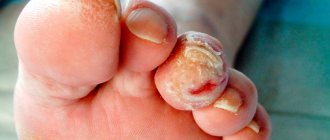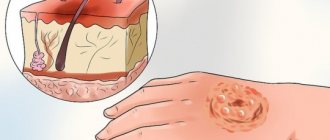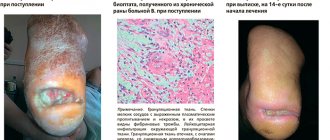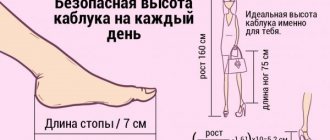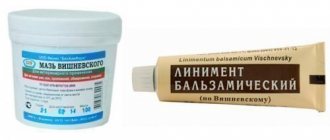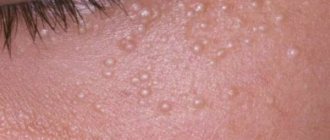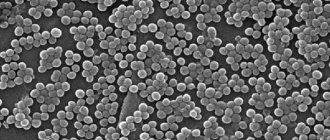When a burn blister is localized in an inconvenient place (arms, feet), many are tormented by the thought: is it possible to pierce a burn blister ? In some cases this is appropriate, but before doing this you definitely need to weigh the pros and cons again. A blister that appears after a burn protects the wound from possible contamination and the entry of bacteria into it; puncturing invariably provokes infection with subsequent suppuration.
Duration of healing of blisters
Often the blisters go away on their own within 10-14 days. But for such healing to occur, it is necessary to treat the problem area with prescribed specialized medications and avoid re-traumatization of the burn site. Sometimes the blisters disappear after a week, but this is only possible with a minor burn and with almost complete absence of damage in the lower layers of the epidermis.
In circumstances where the skin has deep damage, the blister can last for about a month, that is, as long as the therapy lasts. In addition, the healing of blisters may take longer in people with particularly sensitive skin, as well as in young children. But as a rule, in this case we are talking only about a few extra days.
A burn blister on the hand causes discomfort and interferes with work
Stages of healing of burn wounds
Healing of burn blisters takes a long time (from 2 weeks or more). How long the recovery process will take depends on :
- The severity of the burn injury;
- Damage area;
- General condition of the body;
- Patient's age.
The healing process is divided into 3 stages:
- The formation of a fluid-filled bubble due to the rejection of dead cells of the upper layer of the epidermis;
- Granulation . The processes of formation of new skin cells are launched. At the same time, the blister undergoes changes. It becomes sluggish, and the exfoliated skin becomes rougher and dries out over time. On palpation, a rough, rough area of skin is noted at the burn site;
- Epithelization. Old damaged cells are replaced with new ones. That is, a new upper layer of the epidermis is formed, which is replaced by exfoliated tissue. The dead tissue gradually falls off, revealing new pink skin underneath. Gradually, the color of the skin evens out somewhat. However, with more severe burns, cosmetic defects remain noticeable.
Can burn blisters be punctured?
Of course, it is possible to pierce a burn blister, but this procedure actually has no advantages. In fact, if there is no risk of sudden damage to the integrity of the blister in non-sterile conditions, due to its location in an inconvenient place, then the question of whether to pierce a burn blister should not arise at all. There are many reasons why you should not pierce blisters from burns:
- you can get infected;
- provoke increased pain and swelling;
- due to the puncture of the bladder, the burn itself will take longer to heal;
- due to the ingress of pathogens and dirt, a purulent process will begin;
- in particularly serious cases, tissue necrosis is possible, which is quite difficult to stop.
Important: First aid and treatment for a fractured penis
So there are plenty of reasons why burn blisters should not be pierced, and before carrying out such a procedure, you need to weigh all the risks again.
It is worth noting that all of the above problems are possible both with an accidental burst of the bladder, and with an independent or medical puncture, if all precautions were not followed.
Possible complications
Complications can arise in case of improper treatment or delay in seeking medical help. Complications of burns with blisters :
- Attachment of a secondary infection . This often happens when blisters are opened and the rules of asepsis and antisepsis are not followed when treating and dressing the wound;
- Poor circulation at the burn site . With deep burns, extensive colloidal scars are formed that interfere with normal blood flow in the surrounding tissues. In severe cases, this leads to necrosis;
- Sepsis is a general infection of the body. The infection spreads through the bloodstream throughout the body, causing polished failure (severe nonspecific stress reaction of the body);
- Impaired functioning of organs . This often occurs with burns to the eyes, respiratory tract, mouth, esophagus and stomach. In this case, the person may become disabled.
When is it advisable to get a puncture?
It has been emphasized more than once that it is appropriate to puncture blisters only in extraordinary cases. Doctors often do not advise touching the burn area, but it makes sense to eliminate the bubble when it is localized in places subject to pressure or often comes into contact with other objects (shoes, clothing).
Therefore, it is possible to lance and remove fluid from a blister on the feet and hands, as this really makes life difficult for the victim. However, it is unacceptable to pierce a burn blister on your own and it is best to pierce it in a hospital setting or at a clinic doctor. Contacting a specialist will help minimize the likelihood of complications.
When is it necessary to see a doctor?
The formation of blisters indicates deep damage to the soft tissues, that is, not only the upper layer of the epidermis is involved. This is why it is recommended to consult a doctor.
Urgent hospitalization is required in the following cases:
- Large burn area;
- Deep tissue damage (burn of 3rd and 4th degree of severity);
- Signs or risk of shock;
- Burns in children, elderly people and pregnant women;
- Burns of mucous membranes.
Surgeons treat burns with blisters. The patient can independently go to the emergency room or call an ambulance (which will take him to the emergency room or surgical department). In large cities there are burn centers that specialize in treating burns of varying severity.
How to puncture a burn blister?
If the situation develops in such a way that it is not possible to avoid puncturing the blister, then it is important that the procedure is carried out in compliance with all precautions. To begin with, the area affected by the burn, as well as the skin around it, must be treated with an antiseptic (but not with alcohol-containing products).
It is also necessary to disinfect the needle with which you plan to make a puncture (it should be as thin as possible).
Before making a puncture, the skin must be thoroughly disinfected
Then you need to prepare several sterile bandages: one for the puncture procedure, and the second for subsequent dressing. The puncture of the bladder should be carried out at its base, applying a sterile bandage to this place (but not cotton wool, in order to avoid villi getting into the wound).
What could be the consequences?
About 150 species of various microorganisms live on healthy human skin, some quickly turn from harmless to pathogenic. When opening a bladder on your own, there is a high risk of infection, penetration of infection into the wound - microbes living in the skin, sweat or sebaceous glands. By piercing the skin, the victim opens an easy path to their goal.
An inflamed burn will delay healing for months. Blisters that are not punctured, on the contrary, disappear in 1-2 weeks. In addition to redness, the infection causes severe pain, and the body’s possible reaction to it is inflammation of the lymph nodes. In this case, you must immediately consult a doctor, since the next likely development of events may be a deadly disease - blood poisoning (sepsis). Its first symptoms are high fever, vomiting, and severe dizziness.
Opened blisters containing microorganisms threaten the victim with cosmetic defects. After recovery, marks often remain on the skin - scars or cicatrices. Such imperfections can only be removed surgically. Therefore, before embarking on such risky actions, you need to carefully weigh the pros and cons. It is still unsafe to pierce the skin in any case, especially for a non-specialist at home.
Burn Blister: Further Recommendations
Next, you should carefully press on the skin of the bladder and release all the serous cerebrospinal fluid. After this, you need to again treat the problem area with an antiseptic and prepare gauze bandages for everyday wear.
Important: Applying a burn patch
To apply the bandage correctly, you will need a disinfectant and ointment. The use of various creams and alternative medicine in this case should be excluded. If, instead of an ointment, some liquid preparation is used, then it is necessary to completely saturate the entire bandage, which is then applied to the affected area.
The ointment is applied directly to the area of the former bladder. This procedure is repeated three times a day. On top of that, it is important to ensure that the area of the former blister does not get wet and that nothing gets there.
After the procedure, a sterile gauze bandage must be applied to the affected area.
First aid for burns
Blisters can occur either immediately after a burn or after some time. In this case, you must act carefully so as not to break the bubble. First aid for burns with blisters :
- Stop exposure to high temperatures on the skin (remove clothing that has been exposed to hot water, steam, hot fat, etc.);
- Cool the affected area. To do this, use a cold compress (clean cloth is soaked in cold water and applied) or a local cool bath. Pouring cold water from a tap onto a burn wound is prohibited! This will lead to hypothermia and tissue necrosis;
- Gently dry the skin using wetting movements;
- Treat the burn with an antiseptic without alcohol (Miramistin, Chlorhexidine);
- If there is an aerosol for burns in the first aid kit (for example, Panthenol), then spray it evenly on the site of injury;
- Protect the wound from contamination by applying a loose aseptic dressing. It should not tighten or cause discomfort;
- In case of severe burning and pain, you need to take an analgesic, which is in your home medicine cabinet. This will prevent the development of painful shock;
- If there are blisters, a doctor’s consultation is required, so you should call an ambulance or go to the emergency room yourself.
Burn blister: treatment of an opened neoplasm
When the question of whether it is necessary to pierce the burn was answered positively and then the corresponding procedure was carried out, then in the future it is necessary to change the gauze bandage at least once a day if an antiseptic solution is used in the treatment and about 3 times a day if a bactericidal healing ointment was chosen for treatment .
Despite the use of sterile materials for dressings, pathogenic microorganisms will accumulate on it during the healing of the burn. If the dressing is not replaced in a timely manner, it becomes an ideal environment for the growth of bacteria, which slow down the healing process.
When, after opening the blister, it begins to bleed, then chlorhexidine and similar medications should be preferred to treat the wound. In other cases, ointment is still preferable. The following drugs have proven themselves quite well:
- Baneocin;
- Bepanten;
- Dexpanthenol;
- Ichthyol;
- Eplan;
- Calendula ointment.
Bepanten cream accelerates the healing of burns
So, what do you need to consider to prevent sunburn?
- Use a broad-spectrum UVA + UVB sunscreen with a sun protection factor of SPF 30 or higher.
- Apply sunscreen in sufficient quantity to the entire body within 30 minutes. before going outside. It is advisable to reapply the cream every 2 hours. Check the expiration date of the cream first.
- Use balm or lipstick with SPF, and wear sunglasses.
- The optimal hours for sun exposure are in the morning before 10:00 and in the evening after 16:00.
- More clothing means more skin protection, so it is advisable to cover exposed skin in the sun. It is recommended to wear a hat on your head.
If it so happens that you have already received a burn after excessive sun exposure, then you need to understand in what situations it is necessary to consult a doctor? If you have:
- Severe swelling of the skin;
- There is no relief in health for several days;
- Possible skin infection (severe pain, swelling, purulent discharge, fever);
- Blisters cover a large area of skin, or are located on the face, hands, or genitals.
Burn Blister: Other Tips
Before applying these products, you should thoroughly wash and treat your hands with antiseptic. Ointments are applied three times a day, at approximately equal intervals. In circumstances where particles of tissue or traces of dirt were noticed in the wound, it should be washed with chlorhexidine before applying the ointment. Of course, whether it is possible to pierce a burn bladder or not, everyone decides for themselves.
But if a person decides to do this, then he must first take care of purchasing antibacterial agents, healing ointments and sterile materials for dressing. However, if negative consequences are noted after the puncture, then you should not delay a visit to the surgeon, so as not to give a chance to develop suppuration or, even worse, tissue necrosis.
How to prevent
Most cases of childhood burns are the responsibility of parents and other adults who leave children unattended in potentially dangerous places. Therefore, when a child appears in the house, all family members must follow the following rules.
- Do not drink or eat hot food while the baby is in your arms.
- Cook food only on the far burners.
- Keep potentially dangerous objects as far away from the edge of the table as possible.
- When preparing a bath, turn on cold water first, and then hot, thoroughly mixing the layers. Remember that water at a temperature of +50 ℃ can be dangerous for a child!
- For sunbathing, use only early morning hours and use sunscreen.
- If possible, do not use extension cords; try to secure electrical wires and cords so that the child does not grab them if he falls.
- Keep electrical appliances as far as possible from children and water sources.
- Hide candles and matches.
- Keep household cleaning products and other chemicals out of the reach of children.
When to call an ambulance
- the burn occurred in a child under 5 years of age;
- the face, groin area, hands, feet are affected;
- in case of electrical injury;
- the affected area is more than five palms of the child, in children one year old and younger - one palm;
- the child has chills, fever, and loss of sensitivity at the site of the lesion;
- if damage to the respiratory tract or eyes is suspected.
The sooner the victim is in the hands of doctors, the more effective the assistance provided to him will be and the higher the likelihood of a favorable prognosis.
